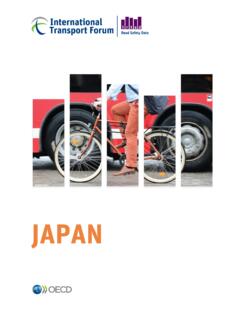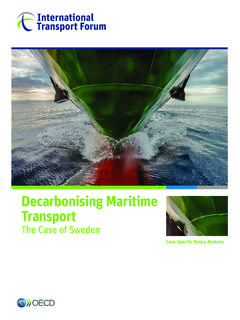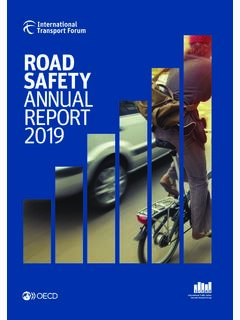Transcription of The Regulatory Asset Base and Project Finance Models
1 01 Discussion Paper 2016 01 Dejan Makov ek and Daniel Veryard International Transport Forum, Paris, FranceThe Regulatory Asset base and Project Finance ModelsAn Analysis of Incentives for Efficiency The Regulatory Asset base and Project Finance Models : An Analysis of Incentives for Efficiency Discussion Paper 2016-1 Dejan Makov ek Daniel Veryard International Transport Forum Paris, France February 2016 2 The International Transport Forum The International Transport Forum is an intergovernmental organisation with 57 member countries. It acts as a think tank for transport policy and organises the Annual Summit of transport ministers.
2 ITF is the only global body that covers all transport modes. The ITF is politically autonomous and administratively integrated with the OECD. The ITF works for transport policies that improve peoples lives. Our mission is to foster a deeper understanding of the role of transport in economic growth, environmental sustainability and social inclusion and to raise the public profile of transport policy. The ITF organises global dialogue for better transport. We act as a platform for discussion and pre-negotiation of policy issues across all transport modes. We analyse trends, share knowledge and promote exchange among transport decision-makers and civil society.
3 The ITF s Annual Summit is the world s largest gathering of transport ministers and the leading global platform for dialogue on transport policy. The Members of the Forum are: Albania, Armenia, Argentina, Australia, Austria, Azerbaijan, Belarus, Belgium, Bosnia and Herzegovina, Bulgaria, Canada, Chile, China (People s Republic of), Croatia, Czech Republic, Denmark, Estonia, Finland, France, Former Yugoslav Republic of Macedonia, Georgia, Germany, Greece, Hungary, Iceland, India, Ireland, Israel, Italy, Japan, Korea, Latvia, Liechtenstein, Lithuania, Luxembourg, Malta, Mexico, Republic of Moldova, Montenegro, Morocco, the Netherlands, New Zealand, Norway, Poland, Portugal, Romania, Russian Federation, Serbia, Slovak Republic, Slovenia, Spain, Sweden, Switzerland, Turkey, Ukraine, the United Kingdom and the United States.
4 International Transport Forum 2 rue Andr Pascal F-75775 Paris Cedex 16 ITF Discussion Papers The ITF Discussion Paper series makes economic research, commissioned or carried out in-house at ITF, available to researchers and practitioners. They describe preliminary results or research in progress by the author(s) and are published to stimulate discussion on a broad range of issues on which the ITF works. Any findings, interpretations and conclusions expressed herein are those of the authors and do not necessarily reflect the views of the International Transport Forum or the OECD.
5 Neither the OECD, ITF nor the authors guarantee the accuracy of any data or other information contained in this publication and accept no responsibility whatsoever for any consequence of their use. This document and any map included herein are without prejudice to the status of or sovereignty over any territory, to the delimitation of international frontiers and boundaries and to the name of any territory, city or area. Comments on Discussion Papers are welcome. Makov ek and Veryard - The Regulatory Asset base model and the Project Finance model ITF Discussion Paper 2016-1 OECD/ITF 2016 3 Abstract Governments world-wide have sought value for money by augmenting the traditional approach to public infrastructure delivery and management by introducing private capital.
6 Two well established platforms for private capital participation are the Regulatory Asset base (RAB) model and the Project Finance model (broadly termed PPPs). This paper reviews available evidence on the efficiency in delivery and operation of major infrastructure of each platform relative to the traditional approach. Overall the basic concern with the RAB model is that its application might lead to excessive capital expenditures, to strategically inflate the base on which the return is being calculated. By contrast, given the complexity of PPP projects and the inherent uncertainty associated with such long-lived contractual commitments, it is questionable whether competition leads to efficient outcomes.
7 Both approaches have some potential advantages and this paper investigates, whether it is meaningful to merge them. Makov ek and Veryard - The Regulatory Asset base model and the Project Finance model 4 ITF Discussion Paper 2016-1 OECD/ITF 2016 Table of Contents 6 Methodology .. 8 The traditional model baseline .. 9 Infrastructure delivery using the traditional model .. 9 Quality and delivery approach .. 9 Delivery efficiency .. 9 Infrastructure operation under the traditional model .. 10 Operational efficiency .. 10 Operational 10 Assessment of the traditional model .. 11 Towards private participation.
8 11 The Regulatory Asset base model .. 12 Overview of the Regulatory Asset base model .. 12 Infrastructure delivery using the RAB model .. 14 Quality and delivery approach .. 14 Delivery efficiency .. 15 Infrastructure operation under the RAB model .. 16 Operational efficiency .. 16 Operational 18 Other value for money considerations for the RAB model .. 18 Cost of debt 18 Estimating the appropriate returns to capital .. 19 The Public-Private Partnership model .. 21 Overview of the PPP model .. 21 Infrastructure delivery using the PPP model .. 22 Quality and delivery approach .. 22 Delivery efficiency .. 23 Infrastructure operation under the PPP model .
9 24 Operational efficiency .. 24 Operational 24 Other value for money considerations for the PPP model .. 25 Cost of debt 25 Risk and return considerations for bidders .. 26 Discussion .. 28 Project RAB Finance .. 29 Summary .. 31 Conclusion .. 33 Bibliography .. 35 Makov ek and Veryard - The Regulatory Asset base model and the Project Finance model ITF Discussion Paper 2016-1 OECD/ITF 2016 5 Boxes Box 1.
10 Cost of financing in RAB and a PPP .. 26 Figures Figure 1. An Regulatory Asset base structure example .. 13 Figure 2. Cost overruns in electricity transmission projects in the USA in 2013 .. 16 Figure 3. An example of a PPP model for infrastructure delivery and operation .. 22 Figure 4. An illustration of the Project RAB Finance during construction .. 30 Tables Table 1. Characteristics of alternative infrastructure delivery and operation 31 Makov ek and Veryard - The Regulatory Asset base model and the Project Finance model 6 ITF Discussion Paper 2016-1 OECD/ITF 2016 Introduction Investment in infrastructure is important for productivity and growth, for future generations as well as today.









